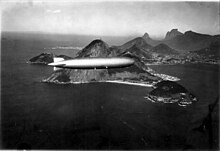German Zeppelin shipping company
Deutsche Zeppelin-Reederei GmbH (DZR) was an airship company from the 1930s.
Emergence
Deutsche Zeppelin-Reederei GmbH was founded on March 22, 1935, initially with its headquarters in Berlin, under the chairmanship of Hermann Göring . The tasks of this company were defined as follows: " (carry out) traffic with airships and all related business, in particular the establishment and operation of regular airship lines for passenger and freight transport." The construction of airships, the construction of airship yards and the Participation in such ventures - these areas were still left exclusively to Luftschiffbau Zeppelin GmbH (LZ) in Friedrichshafen .
It is not entirely clear who was the driving force behind the founding of this new company, the Reich Aviation Ministry in Berlin or the LZ Group, which practically gave up its transport department. Both parties have promised each other advantages, the state, in order to gain a better insight into the way and the use of its grants and to be able to influence the use of the airships more strongly, the LZ Group, a strong partner for its popular, but nonetheless To get a problem child in deficit and to secure the future of commercial aviation. The share capital was 9.55 million Reichsmarks and was taken over by the shareholders as follows:
| Mill. RM | |
|---|---|
| Airship construction Zeppelin | 5.7 |
| Deutsche Lufthansa AG on its own account | 0.4 |
| DLH in trust for the Reich Aviation Ministry | 3.45 |
The "contributions" are informative:
| Mill. RM | ||
|---|---|---|
| LZ | LZ 127 "Graf Zeppelin" | 1.9 |
| 7/13 ownership of LZ & 129 "Hindenburg" | 3.5 | |
| cash deposit | 0.3 | |
| DLH | 6/13 ownership of LZ 129 | 3.0 |
| cash deposit | 0.85 |
The "capital" of the DZR therefore essentially consisted of the two airships LZ 127 "Graf Zeppelin" and the LZ 129 "Hindenburg" (which was not yet completed at the time of foundation).
The managing directors were Captain Ernst A. Lehmann and the police chief of Magdeburg, Carl Christiansen, who gave up his position after a few months and was appointed to Walter Issel (December 1936). In addition to Hugo Eckener as chairman of the ministerial councilor, Albert Mühlig-Hofmann (RLM), director Freiherr Carl August von Gablenz (DLH) and director M. Wronsky (DLH) sat on the supervisory board . One of the most important measures in 1935 was the complete reorganization of the agency system, whereby Hapag 's monopoly was taken away . Hapag also had to cut back on commission from 10 percent to 7.5 percent.
activity
The operating result in 1935 could be balanced with only 47 percent income with 53 percent Reichshilfen.
On March 19, 1936, the airship LZ 129 "Hindenburg" was officially approved for passenger transport and at the same time handed over to the DZR. With two airships, a number of trips to North America could now be undertaken in addition to the South America service. The DZR requested the construction of a second airship hangar for the new Frankfurt am Main airport , which was commissioned by the airship port company. Frankfurt developed into the focus of operations, and the construction of a separate settlement for the employees was tackled.
On June 30, 1936, the DZR commissioned a sister ship of the "Hindenburg", LZ 130, for 5.5 million RM from Luftschiffbau Zeppelin . Completion was scheduled for October 1937.
In the new financial year, on the basis of a resolution by the supervisory board and shareholders' meeting on December 16, 1936, a second ship (LZ 131) was ordered in Friedrichshafen for a price of RM 6.3 million.
The profitability could be increased slightly from 47 percent (1935) to 57 percent (1936), accordingly the Reichshilfe decreased from 53 percent (1935) to 43 percent (1936). Everything looked like a favorable further development, but here, too, the accident at Lakehurst meant a turning point. The destroyed LZ 129 "Hindenburg" was insured for 6 million RM, which was paid out in full (the crew members and passengers were also fully insured for disability and death), but the passenger trips could no longer be started.
Services
The DZR initially offered tours from Friedrichshafen and later from Frankfurt to Lakehurst near New York and Rio de Janeiro .
The trip to Lakehurst took around three days and cost 1,000 Reichsmarks . The trip to Rio de Janeiro led via Recife and lasted about four days and cost 1,500 Reichsmarks; whoever got out in Recife saved a hundred.
The information here come schedules of 1934 and 1936. The Wikipedia gives for this period an annual average wage of workers of German of 1,700 Reichsmarks. From an American perspective, 1,000 Reichsmarks was the equivalent of about $ 400, or just under a third of the median annual US income.
See also
- Deutsche Zeppelin-Reederei (2001) - an airline of the same name today
- Former Airlines List (Europe)
literature
- L. Tittel: LZ 129 "Hindenburg". 4th, revised. Edition. Zeppelin Museum Friedrichshafen , 1997, ISBN 3-926162-55-4 .
- M. Bauer, J. Duggan: LZ 130 “Graf Zeppelin” and the end of commercial aviation. Zeppelin Museum Friedrichshafen, 1998, ISBN 3-926162-79-1 .
- P. Kleinheins: The big zeppelins. The history of airship construction. 3rd, revised. Edition. Springer, Berlin / Heidelberg / New York 2005, ISBN 3-540-21170-5 .
Web links
- Early documents and newspaper articles on the Deutsche Zeppelin-Reederei in the 20th Century press kit of the ZBW - Leibniz Information Center for Economics .
Individual evidence
- ↑ K. Clausberg: Zeppelin: The story of an improbable success. Augsburg 1990, ISBN 3-89350-030-8 , p. 172 f.
- ↑ AC Bergmann: CargoLifter: How it all began. Berlin 2001, OCLC 918452039 , p. 59.


